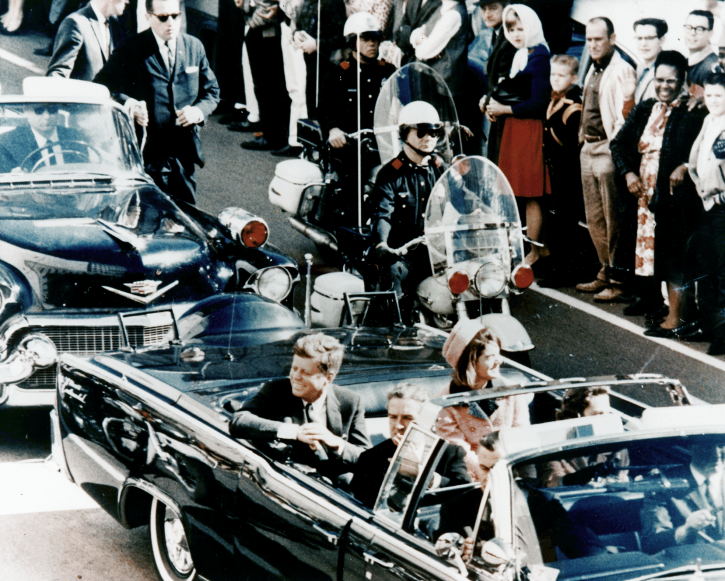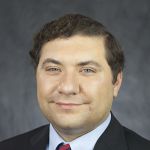The JFK Assassination 50 Years Later
This year is the 50th anniversary of President Kennedy’s assassination. Many focus on conspiracy theories, but is there a greater legacy we should focus on?
John F. Kennedy, and his wife, Jacqueline, greet the crowd in their limousine in Dallas, Texas, minutes before his assassination (Photo from Wikimedia Commons)
The Kennedy assassination has been one of the most studied events in American history. It has given rise to dozens of conspiracy theories postulating numerous explanations for how and why President Kennedy was shot in Dealey Plaza on the afternoon of Nov. 22, 1963. Refusing to believe the accepted history that President Kennedy was shot by Lee Harvey Oswald alone, theories have been presented blaming the CIA, FBI, U.S. military establishment, the Mafia, the Texas political establishment, Fidel Castro, Cuban exiles and even Vice President Lyndon Johnson for the murder of President Kennedy. Some conspiracy theorists even believe more than one of the above parties conspired together to assassinate the president.
These conspiracy theories are not just accepted by fringe elements of society. In fact, the majority of Americans polled—59 percent—believe at least two gunmen were responsible and that a conspiracy was behind Kennedy’s death.
Sadly, many Americans’ opinion on this topic was shaped and influenced by the 1991 Oliver Stone film JFK. This movie, though very good filmmaking, was poor history and seemed to blame nearly every government agency for the assassination while portraying Lee Harvey Oswald as an innocent patsy—unjustly framed for the assassination because of his pro-Soviet leanings.
The fact is that evidence has never been presented to prove any of the above theories.
The reason for conspiracy theories
Why do people desire to believe that Kennedy was not killed by Oswald, but by a high-level conspiracy?
It is difficult for people to accept that the most powerful man on earth could have died at the hands of someone so inconsequential as a warehouse worker like Lee Harvey Oswald.
The underlying reason that people have difficulty accepting that President Kennedy was killed by Oswald alone was eloquently summed up by historian William Manchester, who researched the assassination thoroughly:
“Those who desperately want to believe that President Kennedy was the victim of a conspiracy have my sympathy. I share their yearning. To employ what may seem an odd metaphor, there is an esthetic principle here. If you put six million dead Jews on one side of a scale and on the other side put the Nazi regime—the greatest gang of criminals ever to seize control of a modern state—you have a rough balance: greatest crime, greatest criminals. But if you put the murdered President of the United States on one side of a scale and that wretched waif Oswald on the other side, it doesn’t balance. You want to add something weightier to Oswald. It would invest the President’s death with meaning, endowing him with martyrdom. He would have died for something. A conspiracy would, of course, do the job nicely. Unfortunately, there is no evidence whatsoever that there was one” (“No Evidence for a Conspiracy to Kill Kennedy,” New York Times, Feb. 5, 1992).
This writer, at least, believes Manchester’s observation is correct.
It is difficult for people to accept that the most powerful man on earth—a beloved president like John F. Kennedy—could have died at the hands of someone so inconsequential as a warehouse worker like Lee Harvey Oswald. Because the dichotomy between the two men is so great, it is natural to imagine there must have been a great conspiracy of a powerful institution to murder a great and powerful president.
Historical significance of the assassination
Historians mark the Kennedy assassination as an important turning point in history. Many believe that the death of President Kennedy marked the true end of the predominantly docile 1950s and the real beginning of the 1960s. The ’50s were characterized by adherence to traditional values, conformity and prosperity. But tension was building under the surface that was released in the ’60s. The ’60s marked a turbulent era of American history when traditional values began to be challenged and conformity was mocked. Though good things—such as the Civil Rights movement—came out of this era, many evils came out as well.
Some of the evils that came out of the ’60s were youth rebellion, the prominence of drugs, “free love,” abortion and the moral “collateral damage” of the birth-control pill (which removed some of the consequences of having sex outside of marriage), radical feminism and the overall challenging of traditional Judeo-Christian values.
We still live in the shadow of the ’60s today. The negative trends that were revolutionary in the ’60s have crept into the cultural consciousness of America today and have become the new normal. Many of the selfish attitudes and ungodly trends that escalated in the ’60s were prophesied in 2 Timothy 3:1-5. Try reading these verses and comparing them with our society today.
The legacy America should consider
As this nation commemorates the tragic death of its 35th president, it should remember the accomplishments of President Kennedy. His handling of the Cuban Missile Crisis in 1962 may well have averted a potential nuclear war (although the failed Bay of Pigs invasion of 1961 is believed to have emboldened the Soviets to place the missiles in Cuba in the first place) and his visionary initiative to put a man on the moon before the end of the 1960s are part of President Kennedy’s legacy.
As far as the 50th anniversary of President Kennedy’s assassination goes, Americans should ponder the long-term legacy of this tragic event. They should ponder where the nation has gone as a society since November 1963.
In his famous inaugural address delivered on Jan. 20, 1960, President Kennedy spoke this message to the nation: “Now the trumpet summons us again—not as a call to bear arms, though arms we need; not as a call to battle, though embattled we are—but a call to bear the burden of a long twilight struggle, year in and year out, ‘rejoicing in hope, patient in tribulation’—a struggle against the common enemies of man: tyranny, poverty, disease, and war itself.”
The four “common enemies of man” enumerated by President Kennedy are truly enemies that must—and will—be defeated. But more enemies must be added, and they are found in 2 Timothy 3:1-5. They are enemies of man—enemies of man’s character.
Even if your nation is losing the battle against these enemies now, you can help show the way by defeating them yourself—now in your life!
The best place to start is by heeding the core message of Jesus Christ: “Repent, and believe in the gospel” (Mark 1:15).
To learn what will happen to America unless it repents; read our article “What Is Going to Happen to America?”
Date Posted: November 20, 2013

 by Erik Jones
by Erik Jones

